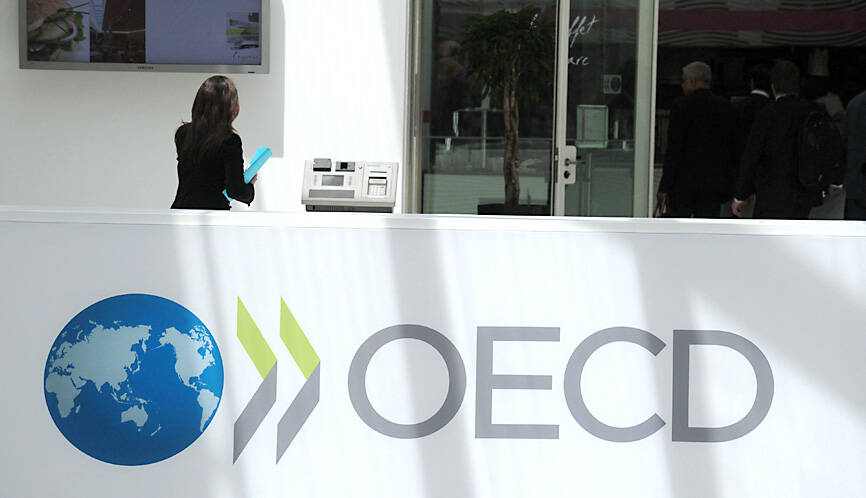The Organisation for Economic Co-operation and Development (OECD) yesterday warned that protectionist trade measures pose a major risk to the world economy, just weeks before US president-elect Donald Trump is to return to the White House next month.
The Paris-based OECD did not name Trump in its updated analysis of the world economy, but it was abundantly clear that the organization was warning about Trump’s possible tariff measures on US trading partners.
While the OECD raised its global growth forecast to 3.3 percent next year, it said that “greater trade protectionism, particularly from the largest economies” poses a “downside risk” along with geopolitical tensions and high public debts.

Photo: AFP
“Increases in trade-restrictive measures could raise costs and prices, deter investment, weaken innovation and ultimately lower growth,” the OECD said in its economic outlook.
“Further increases in global trade restrictions would add to import prices, raise production costs for businesses and reduce living standards for consumers,” it added.
A recent study by the Roland Berger consultancy calculated the cost of the US measures, and likely countermeasures by China and the EU, at more than US$2.1 trillion through 2029.
Trump is far from the only risk in terms of protectionist measures. A spat has also broken out between Brussels and Beijing after the EU imposed import tariffs on Chinese electric vehicles. China has retaliated with tariffs on EU brandy, including cognac.
The OECD sees the US economy expanding 2.4 percent next year, up from its September forecast of 1.6 percent growth. It also raised its forecast for the UK’s growth next year 0.5 percentage points to 1.7 percent due to higher public spending planned by the new Labour Party government.
China’s economy is expected to expand 4.7 percent next year, an increase of 0.2 percentage points, while India’s growth forecast was raised 0.1 percentage points to 6.9 percent.
However, France and Germany saw 0.3 percentage point cuts to their growth forecasts to 0.9 percent and 0.7 percent respectively, as both countries face political crises amid mounting fiscal pressure, the OECD said.

PERSISTENT RUMORS: Nvidia’s CEO said the firm is not in talks to sell AI chips to China, but he would welcome a change in US policy barring the activity Nvidia Corp CEO Jensen Huang (黃仁勳) said his company is not in discussions to sell its Blackwell artificial intelligence (AI) chips to Chinese firms, waving off speculation it is trying to engineer a return to the world’s largest semiconductor market. Huang, who arrived in Taiwan yesterday ahead of meetings with longtime partner Taiwan Semiconductor Manufacturing Co (TSMC, 台積電), took the opportunity to clarify recent comments about the US-China AI race. The Nvidia head caused a stir in an interview this week with the Financial Times, in which he was quoted as saying “China will win” the AI race. Huang yesterday said

Nissan Motor Co has agreed to sell its global headquarters in Yokohama for ¥97 billion (US$630 million) to a group sponsored by Taiwanese autoparts maker Minth Group (敏實集團), as the struggling automaker seeks to shore up its financial position. The acquisition is led by a special purchase company managed by KJR Management Ltd, a Japanese real-estate unit of private equity giant KKR & Co, people familiar with the matter said. KJR said it would act as asset manager together with Mizuho Real Estate Management Co. Nissan is undergoing a broad cost-cutting campaign by eliminating jobs and shuttering plants as it grapples

The Chinese government has issued guidance requiring new data center projects that have received any state funds to only use domestically made artificial intelligence (AI) chips, two sources familiar with the matter told Reuters. In recent weeks, Chinese regulatory authorities have ordered such data centers that are less than 30 percent complete to remove all installed foreign chips, or cancel plans to purchase them, while projects in a more advanced stage would be decided on a case-by-case basis, the sources said. The move could represent one of China’s most aggressive steps yet to eliminate foreign technology from its critical infrastructure amid a

MORE WEIGHT: The national weighting was raised in one index while holding steady in two others, while several companies rose or fell in prominence MSCI Inc, a global index provider, has raised Taiwan’s weighting in one of its major indices and left the country’s weighting unchanged in two other indices after a regular index review. In a statement released on Thursday, MSCI said it has upgraded Taiwan’s weighting in the MSCI All-Country World Index by 0.02 percentage points to 2.25 percent, while maintaining the weighting in the MSCI Emerging Markets Index, the most closely watched by foreign institutional investors, at 20.46 percent. Additionally, the index provider has left Taiwan’s weighting in the MSCI All-Country Asia ex-Japan Index unchanged at 23.15 percent. The latest index adjustments are to